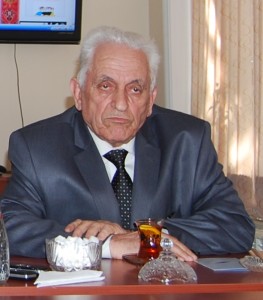
 The fact that the Armenians are not autochthonous to the Caucasus is a proven fact by the experts.
The fact that the Armenians are not autochthonous to the Caucasus is a proven fact by the experts.The Armenian language has nothing to do with the Caucasian languages. It belongs to the Indo-European language family. As known, a language family includes various groups. A number of scholars, including I. Dyakonov believe that the Armenian language is close to the Greek language. This fact demonstrates that the Greeks and Armenians lived in the same region and influenced each other at some stage of history. However, the Armenians do not belong to the Near East.
They arrived in the Near East not earlier than the middle of the second millennium BC. Most likely, they relocated to Asia Minor during the Great Migration. The Armenians were first mentioned in the Epitaph of Darius at Bisutun. The inscription, which was written in 520-518 BC, mentions the land named Ermeniyye several times.
They were dependent and a part of the Achaemenid state. The inscription refers to the rebellion against the empire. The independence of the Armenians was also out of question during the period of Alexander the Great, who defeated the Achaemenids. Because no people enjoyed independence within Alexander’s empire. One part of the Caucasus was independent at that time as Alexander the Great had not reached the region. The inhabitants of the area was Kaspis in the 5th century BC, the Albanians later.
The Armenians claim to have a short-lived independent state during Artaxias (Artashes) in the 2nd century BC. Tigran II, who was a hostage by the Partian kings in 96-95 BC, paved way to power through some shady agreements. After strengthening his power, he raided to Syria and captured a number of cities. In 69 BC the Roman army led by Lucullus launched the eastern campaign. He destroyed the city of Tigranocerta in the upper reaches of the Tigris River. According to the Armenian researcher Sargsyan, the city of Tigranocerta was founded not earlier than 87 BC. Tigran II never marched to the Caucasus, therefore, the city of Tigranocerta was not in the Caucasus. After Lucullus was recalled to Rome, Pompey carried out the next campaign and defeated Tigranes. He presented all his treasure to Pompey and kneeled in front of him.
In other words, the Armanians did not have a state in the Caucasus. Of course, there could be Armenians in the Caucasus. “Great Armenia from sea to sea” is just a dream. While at most 7-8 million Armenians currently live in the world, their number was quite low at that time.
In his 1911 book, a Russian scholar Shavrov wrote that nearly 300,000 Armenians had inhabited the Caucasus until the 1828 Treaty of Turkmenchay. In the early 20th century, their number in this region reached 1.3 million, 1 million out of which was resettled by the Russian authorities. The works by Paskevich and Griboyedov reflect that resettlement. The Russian authorities paid a special attention to Armenians adoption in terms of climate changes, while deported Azerbaijanis from mountainous areas to planes many years later.
The Armenians were resettled to Karabakh especially in summer, when Azerbaijanis were in mountains. Therefore, these areas are not Armenian. They simply claimed many religious monuments. In the first half of the 4thcentury, the Caucasian Albanians converted to Christianity, which became their official religion.
In the mid-5th century Byzantium and the Sassanids were at state of war. Alerted by possibility pro-Byzantium course of Christian Albanians, the Sassanids began to spread Zoroastrianism in the area. Despite Zoroastrian communities, the majority of population was Christian. Therefore, the Sassanid authorities invited princes and pressed them to adopt Zoroastrianism. Under the threat of invasion, part of Albanians adopted Zoroastrianism in 450. However, after only a year, the people revolted and drove Zoroastrian priests out of the country.
During the Islamic caliphate, the Christian Albanians were not touched, while the Zoroastrians were converted to Islam. Christians lived in this area for a long time. Mkhitar Gosh even elaborated a code of laws for the Christian population.
In 1836, the Synod under the Russian Emperor made the Albanian churches subordinate to the Armenian church. To avoid pro-Iranian and pro-Turkish tendencies of the Muslims living in an extremely important strategic region, the Russian authorities resettled masses of Armenians, thus, launching their “divide and rule” method. They tried to separate us from our roots and benefitted from Armenians against us.
There are accurate Russian military topographic maps dated 1808-1809. As known, a special attention is paid to correct spelling of toponyms on military maps. One can find innumerable toponyms of Azerbaijani origin in the territory of the present-day Armenian on those maps. They should be re-printed in order to deliver historical truth to the world community.
Ilyas Babayev,
Corresponding member of Azerbaijan National Academy of Sciences
Corresponding member of Azerbaijan National Academy of Sciences
http://1905.az/
